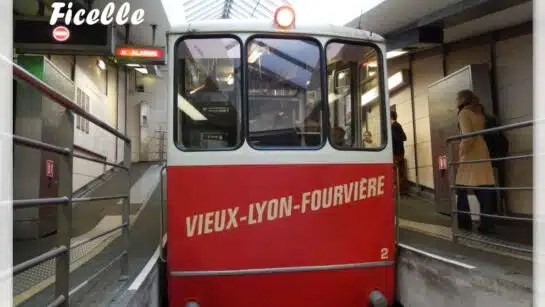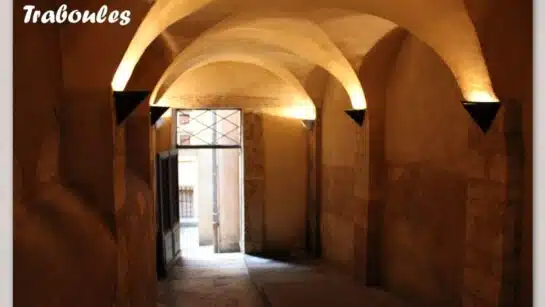Charles Lodge, a British Romanophile, takes to the streets of Lyon and uncovers the eclectic Roman heritage tucked around almost every corner.
Very considerate, I thought. The Romans, that is. Not only did they build the greatest empire in the Ancient world, but had great foresight for the future by providing very useful parking places for bikes, motorbikes and scooters! How could they have known that their edifices could have some tangible use in two thousand years’ time?
Trion, one of the oldest quarters of Lyon
This was one of the many crazy thoughts that went through my head as I walked the streets of Lyon earlier this year.
I happened to be in Trion, one of the oldest quarters of this beautiful city, and I noticed just off the pavement, happily sitting in a tree-lined square, a large and beautifully carved Roman fountain. It was quietly posed where pedestrians pass to and fro every day to go to work, to the shops, to have a swift one in the local bar.

Lego Roman
Almost unassuming it has been content to sit there for all this time, no doubt being used, abused and latterly, feted, and for some people is a very useful place to dump your bicycle or whatever whilst you go about your business.
That it is still here is amazing in itself, but to find that it is quietly integrated into modern society is extraordinary.
In many other countries a structure with such history as this would have been the subject of huge publicity, removed to a museum and placed inside a reinforced glass display unit. Not here in Lyon, that just doesn’t happen.
And the reason? Well, there are so many ancient Roman relics, the city is literally swamped!
“For lovers of antiquity Lyon is a must”
So this is just one of hundreds of examples of the Roman occupation of the city.
Of course it wasn’t known as ‘Lyon’ in those days, it was called ‘Lugdunum’, the Roman capital of Gaul of huge strategic importance to the Romans, as it formed the crossroads between the north and south of the empire, with the Rhône and Saône providing very useful navigable waterways linking to the important Mediterranean port of Massalia (Marseille), and roads to the east towards Germany and west towards Aquitaine.
So what is left of this city of Lugdunum today? The answer is ‘a great deal’. For lovers of antiquity Lyon is a must.

Fourviere’s Roman Theatre
Apart from being a beautiful modern city with a buzz that may only be surpassed by Paris, and a culinary reputation that can be outdone by literally nowhere, its Roman history is everywhere.
For those who like to stretch their legs and discover, then the ancient quarters of St Just, St Irenee, St Georges and Fourviere are full of sites and relics to visit, many within easy walking distance.
The first stop has to be the Theatre and Amphitheatre situated off rue de l’Antiquaille in the Fourviere quarter. Built at differing times during the Roman period, these two sites offer an unparalleled insight into the importance of the location of Lugdunum.
Occupying the high ground to the west of the Saône, you are afforded far reaching views to the north, east and south with the Alps and Mont Blanc visible on clear days and in the foreground views over the two rivers.
Of course today a thriving modern city is the vista, and whilst that in itself is an appealing sight, rolling back the centuries one can imagine why the location was chosen.
The Roman Theatre, a living place
The ruins of the Theatre and Amphitheatre have been carefully preserved and have been classified as Historic Monuments since 1905, but are by no means a sterile relic of the past.
They are very much living places in today’s world, with concerts and ‘spectacles’ being staged here throughout the year, bringing people together to enjoy entertainment and history at the same time.

Concerts at the Roman Amphitheatre. Nuits de Fourvière. ©LollWillem
You are able to freely walk around the site and wonder at the architecture and the engineering of the period and even linger in the neighbouring park for a picnic or mere contemplation.
Just a short walk away in the St Just quarter, hidden behind a rather imposing modern block of apartments in rue des Farges, you will find the ruins of an ancient Roman Bath complex.
Discovered when excavating for the construction of the apartments, these baths were constructed during the 1st century AD and enlarged in the following century, to include a market, shops and homes.
Access to the site is via an archway in the modern structure which leads to the rear of the building. A further five minute walk along the road will bring you to the remains of a Roman Mausoleum with several structures proudly standing.
“Some of the finest Roman artefacts to be found anywhere in France”.
The three sites that I have touched on are just a miniscule part of the legacy of the Romans here in Lyon and I cannot emphasise strongly enough how easy it is to see and appreciate them, either on foot or bicycle, public transport, or car.
I have made no mention of the Amphitheatre des Trois Gauls in the Croix Rousse quarter, which was the first amphitheatre to be constructed in the city.
I’ve made no mention of the Aquaducts of Gier and the three other aquaducts that were constructed to supply the expanding city of Lugdunum with fresh water. I
n various locations around the modern city of Lyon, one can find impressive sections of the structures still standing, all of which are worthy of a visit.
“Lyon is such a great place to explore”
I’ve left the most important for last; the Musee Gallo-Romain de Lyon. Situated in rue Cleberg, close to the magnificent 19th century Basilica at Fourviere (itself a great spectacle to see), this museum is a treasure trove of everything Roman in and around Lyon.
You could spend a whole day in this museum and still not see every exhibit. From the early settlement of the Fourviere hill, through to its expansion, prosperity and eventual downfall, all is superbly documented here and furthermore supported with some of the finest Roman artefacts to be found anywhere in France.
Lyon is such a great place to explore. Around every corner there’s something to discover. If history is your thing, then you’ll be totally in seventh heaven.
If you think history is a stuffy old subject that has no relevance to your life, then I’d say, ‘Hang on a minute! Come here and you might just change your mind. History is a part of this city. Lyon is Lugdunum, Lugdunum is Lyon!’



